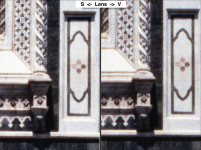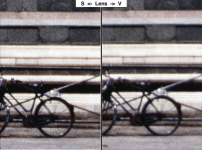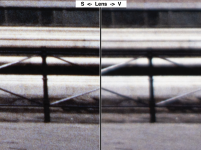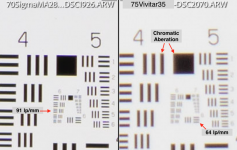ColSebastianMoran
( IRL Richard Karash )
I've done a lot of lens testing for 1x camera-scanning. Some of my results are documented in this thread here on RFF.
I can see real differences with my very clean USAF glass test target, and have divided 50+ lenses into five groups based on resolution and freedom from aberations. But, do these differences on test-targets produce a visible difference in prints? And, is it worth obsessing on getting the very best 1x macro lens for camera scanning.
So, I shot some tests with two lenses. One is a very top current lens, the second is a cheap old lens that falls in the 3rd or 4th of my five groups by image quality.
Here is the overall image, a camera-scan of a good chrome, the Duomo in Florence, just for reference. At this resolution, 1000 pixels, we won't distinguish the two lenses.
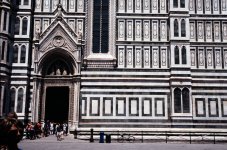
If you are interested in my question, you'll want to look at high-res files for these two camera scans. Here are jpg's 5500 pixels wide, unsharpened for inspection, I would sharpen first to taste and then print at 12x18". These files are about 10MB each.
Lens S 5500 pixel file: http://2under.net/images/LensS-Duomo-f8-AR40516-5kNS.jpg
Lens V 5500 pixel file: http://2under.net/images/LensV-Duomo-f8-AR40522-5kNS.jpg
In next entries, I'll show some actual pixel comparisons.
I can see real differences with my very clean USAF glass test target, and have divided 50+ lenses into five groups based on resolution and freedom from aberations. But, do these differences on test-targets produce a visible difference in prints? And, is it worth obsessing on getting the very best 1x macro lens for camera scanning.
So, I shot some tests with two lenses. One is a very top current lens, the second is a cheap old lens that falls in the 3rd or 4th of my five groups by image quality.
Here is the overall image, a camera-scan of a good chrome, the Duomo in Florence, just for reference. At this resolution, 1000 pixels, we won't distinguish the two lenses.

If you are interested in my question, you'll want to look at high-res files for these two camera scans. Here are jpg's 5500 pixels wide, unsharpened for inspection, I would sharpen first to taste and then print at 12x18". These files are about 10MB each.
Lens S 5500 pixel file: http://2under.net/images/LensS-Duomo-f8-AR40516-5kNS.jpg
Lens V 5500 pixel file: http://2under.net/images/LensV-Duomo-f8-AR40522-5kNS.jpg
In next entries, I'll show some actual pixel comparisons.
ColSebastianMoran
( IRL Richard Karash )
ColSebastianMoran
( IRL Richard Karash )
ColSebastianMoran
( IRL Richard Karash )
ColSebastianMoran
( IRL Richard Karash )
My point in all this is that I think the inferior lens makes a file that will work fine for many uses, and will make an acceptable 12x18" print.
For archival scans or for perfect prints, take one of the top lenses. For most uses, lenses in my first two groups will be fine. For some uses, a $50 bargain may be good enough.
The two lenses here:
- Lens S is the 70mm f/2.8 Sigma Macro ART, my go-to lens, one of a dozen lenses producing what I think are equal results. Around $550 in the US today.
- Lens V is the 75mm f/3.5 Vivitar "Flat Field Lens" one of many easy to buy enlarging lenses.
For archival scans or for perfect prints, take one of the top lenses. For most uses, lenses in my first two groups will be fine. For some uses, a $50 bargain may be good enough.
The two lenses here:
- Lens S is the 70mm f/2.8 Sigma Macro ART, my go-to lens, one of a dozen lenses producing what I think are equal results. Around $550 in the US today.
- Lens V is the 75mm f/3.5 Vivitar "Flat Field Lens" one of many easy to buy enlarging lenses.
ColSebastianMoran
( IRL Richard Karash )
Here are my best tested lenses.
Testing done at 1x to 50MPx Sensor, mid-corner, from glass USAF Test target (which has perfect lines to 224 lp/mm)
Best lenses Resolving G6-E4 at extinction 91 lp/mm to 50MPx 3.8µ sensor, MTF50 roughly G4-E6 29 lp/mm (5-Star)
50 f/2.8 Sigma EX DG macro
50 f/4.5 Tominon
55 f/2.8 Micro-Nikkor AI or AIS
70 f/2.8 Sigma Macro ART
75 f/4 APO Rodagon-D 1x Copy Lens
75 f/4.5 APO Rodagon-D 2x Copy Lens, Normal Orientation
90 f/2.8 Sony Macro
ScanNikkorED14 which is ~100mm f/2.x from CoolScan 8000/9000 lens
Testing done at 1x to 50MPx Sensor, mid-corner, from glass USAF Test target (which has perfect lines to 224 lp/mm)
Best lenses Resolving G6-E4 at extinction 91 lp/mm to 50MPx 3.8µ sensor, MTF50 roughly G4-E6 29 lp/mm (5-Star)
50 f/2.8 Sigma EX DG macro
50 f/4.5 Tominon
55 f/2.8 Micro-Nikkor AI or AIS
70 f/2.8 Sigma Macro ART
75 f/4 APO Rodagon-D 1x Copy Lens
75 f/4.5 APO Rodagon-D 2x Copy Lens, Normal Orientation
90 f/2.8 Sony Macro
ScanNikkorED14 which is ~100mm f/2.x from CoolScan 8000/9000 lens
ColSebastianMoran
( IRL Richard Karash )
Here are my Group 2 lenses. I think result from these on real images will be hard to distinguish from Group 1 lenses.
Group 2, still excellent, slightly less contrast or Resolution (4-Star)
Resolving G6-E3 81 lp/mm, MTF50 at roughly G4-E4 23 lp/mm
35 f/4.5 Tominon
50 f/3.5 Canon FD Macro - Good contrast, no CA, MTF50 is G4-E4
50 f/4.5 Focotar
50 f/2.8 Componon-S
60 f/2.8 Micro-Nikkor AF
75 f/4.5 APO-Rodagon-D 2x (Normal mount at 1x; for 2x, reversed is better)
80 f/4 Olympus Bellows Macro
80 f/4 APO Rodagon-N 6-3 with lower contrast
80 f/5.6 Rodagon Fixed Aperture
80 f/5.6 Componon
80 f/4 Componon-S 6-3 with somewhat lower contrast
90 f/2.8 Tamron SP Macro
90 f/2.5 Vivitar Macro w/1x Extender
105 f/2.8 Micro-Nikkor AF-D, with manual focus on Sony
Group 2, still excellent, slightly less contrast or Resolution (4-Star)
Resolving G6-E3 81 lp/mm, MTF50 at roughly G4-E4 23 lp/mm
35 f/4.5 Tominon
50 f/3.5 Canon FD Macro - Good contrast, no CA, MTF50 is G4-E4
50 f/4.5 Focotar
50 f/2.8 Componon-S
60 f/2.8 Micro-Nikkor AF
75 f/4.5 APO-Rodagon-D 2x (Normal mount at 1x; for 2x, reversed is better)
80 f/4 Olympus Bellows Macro
80 f/4 APO Rodagon-N 6-3 with lower contrast
80 f/5.6 Rodagon Fixed Aperture
80 f/5.6 Componon
80 f/4 Componon-S 6-3 with somewhat lower contrast
90 f/2.8 Tamron SP Macro
90 f/2.5 Vivitar Macro w/1x Extender
105 f/2.8 Micro-Nikkor AF-D, with manual focus on Sony
ColSebastianMoran
( IRL Richard Karash )
Group 3 lenses. Still good; will be able to see differences on real images in very large prints or in pixel-peeping.
Note: When used a lower magnification or on APS body, results will be closer to lenses above.
Group 3, less resolution G6-E2 and MTF50 still around G4-E4 (3-Star)
50 f/1.8 Olympus Zuiko (on Vivitar Macro Focusing Teleconverter, low contrast, some CA)
50 f/2.8 El-Nikkor (Old style, metal body, huge numerals) Some CA
50 f/2.8 Componon-S
50 f/3.5 Olympus Zuiko Macro
50 f/4 Componon (less contrast, old, small lens)
50 f/4 El-Nikkor
50 f/4.5 Enlarging Ektar
55 f/2.8 Industar (s/n 92xxx from 1992; some CA, removed in LR)
55 f/2.8 Panagor Macro (also sold as Vivitar, Komine) Vivitar
55 f/2.8 Yashica ML Macro
55 f/3.5 Micro Nikkor (s/n 899x, late model, some CA)
55 f/3.5 Micro Nikkor (s/n 204x, early, compensating aperture, some CA)
60 f/2.8 7Artisans Micro version I (less contrast, some CA, APS only, version II of this lens is considerably better)
75 f/4 El-Nikkor
75 f/4.5 Enlarging Ektar, MTF50 G4-E4
75 f/4.5 Tominon
90 f/5.6 Komura Enlarging lens (less contrast)
100 f/4 Canon FD Macro (some CA, MTF50 at G4-E3)
100 f/2.8 Canon EF L Macro on 5DSR or on Sony (considerable CA)
100 f/4 Pentax Bellows (some CA)
100 f/4 Leica Bellows Elmar (G6-E2, good contrast)
Note: When used a lower magnification or on APS body, results will be closer to lenses above.
Group 3, less resolution G6-E2 and MTF50 still around G4-E4 (3-Star)
50 f/1.8 Olympus Zuiko (on Vivitar Macro Focusing Teleconverter, low contrast, some CA)
50 f/2.8 El-Nikkor (Old style, metal body, huge numerals) Some CA
50 f/2.8 Componon-S
50 f/3.5 Olympus Zuiko Macro
50 f/4 Componon (less contrast, old, small lens)
50 f/4 El-Nikkor
50 f/4.5 Enlarging Ektar
55 f/2.8 Industar (s/n 92xxx from 1992; some CA, removed in LR)
55 f/2.8 Panagor Macro (also sold as Vivitar, Komine) Vivitar
55 f/2.8 Yashica ML Macro
55 f/3.5 Micro Nikkor (s/n 899x, late model, some CA)
55 f/3.5 Micro Nikkor (s/n 204x, early, compensating aperture, some CA)
60 f/2.8 7Artisans Micro version I (less contrast, some CA, APS only, version II of this lens is considerably better)
75 f/4 El-Nikkor
75 f/4.5 Enlarging Ektar, MTF50 G4-E4
75 f/4.5 Tominon
90 f/5.6 Komura Enlarging lens (less contrast)
100 f/4 Canon FD Macro (some CA, MTF50 at G4-E3)
100 f/2.8 Canon EF L Macro on 5DSR or on Sony (considerable CA)
100 f/4 Pentax Bellows (some CA)
100 f/4 Leica Bellows Elmar (G6-E2, good contrast)
ColSebastianMoran
( IRL Richard Karash )
Group 4 lenses. Will see differences vs above lenses in corners on close inspection of prints.
Fourth Group, lower contrast, MTF around G4-E2. Some still good resolution (2-Star)
50 f/1.8 Nikkor AF on Vivitar Macro Focusing Teleconverter (G5-E6, less contrast)
50 f/3.5 Olympus Zuiko Macro (G6-E1, good contrast, but lots of CA) [vs G3 above??]
55 f/2.8 Vivitar Macro (Komine, G6-E1, lower contrast, not as good as Panagor version)
60 f/3.5 JML (M39, enlarging lens? G5-E6, and MTF50 at G4-E3, CA)
75 f/4.5 Componar (G5-E6, less contrast, some CA, astigmatism)
60 f/4 Noflexar Bellows Macro (G5-E6, lower contrast MTF50 around G4-E1, CA)
60 f/2.8 Zeiss Macro C/Y (G6-E1 at f/8, considerable CAs, MTF50 G4-E4) [SOLD]
75 f/3.5 Vivitar (older, metal body, CA, G6-E1, good contrast)
80 f/5.6 Vivitar VHE (Res G6-E2, lower contrast)
100 f/4 Minolta Bellows Lens (G6-E2, lower contrast)
100 f/3.5 Yashica ML Macro (G6-E3, no CA, but much lower contrast)
105 f/4 Bellows Nikkor (G6-E3, lower contrast)
105 f/4.5 Tominon (Res G6-E3, lower contrast, considerable CAs)
Note: my measure of MTF50 is very rough. In Lightroom, the resolution at which Lightroom measure of contrast between white and black lines is halved.
Fourth Group, lower contrast, MTF around G4-E2. Some still good resolution (2-Star)
50 f/1.8 Nikkor AF on Vivitar Macro Focusing Teleconverter (G5-E6, less contrast)
50 f/3.5 Olympus Zuiko Macro (G6-E1, good contrast, but lots of CA) [vs G3 above??]
55 f/2.8 Vivitar Macro (Komine, G6-E1, lower contrast, not as good as Panagor version)
60 f/3.5 JML (M39, enlarging lens? G5-E6, and MTF50 at G4-E3, CA)
75 f/4.5 Componar (G5-E6, less contrast, some CA, astigmatism)
60 f/4 Noflexar Bellows Macro (G5-E6, lower contrast MTF50 around G4-E1, CA)
60 f/2.8 Zeiss Macro C/Y (G6-E1 at f/8, considerable CAs, MTF50 G4-E4) [SOLD]
75 f/3.5 Vivitar (older, metal body, CA, G6-E1, good contrast)
80 f/5.6 Vivitar VHE (Res G6-E2, lower contrast)
100 f/4 Minolta Bellows Lens (G6-E2, lower contrast)
100 f/3.5 Yashica ML Macro (G6-E3, no CA, but much lower contrast)
105 f/4 Bellows Nikkor (G6-E3, lower contrast)
105 f/4.5 Tominon (Res G6-E3, lower contrast, considerable CAs)
Note: my measure of MTF50 is very rough. In Lightroom, the resolution at which Lightroom measure of contrast between white and black lines is halved.
ColSebastianMoran
( IRL Richard Karash )
A comment: I'm surprised that some high-pedigree lenses (Canon 100 L Macro, Zeiss 60mm f/2.8 Macro C/Y, 100 Bellows Elmar, etc.) show poorly in these demanding tests at 1x. I'll assume that these lenses perform well at other magnifications. Performance at 1x is a tough standard for lenses.
Hope this is helpful.
Hope this is helpful.
pyeh
Member of good standing
Thanks Richard. That's tremendous work.
571514m3
Established
Great approach, well done. What f stop did you use?
Nitroplait
Well-known
Great approach, well done. What f stop did you use?
I'd love to know as well.
I have been happy using my micro-nikkor 55/3.5 - it happened to sit on the used slide copy bellows when I bought it, but it looks like I should consider switching to my micro-nikkor 55/2.8 ais instead.
Of course, when talking old lenses there may be factors of decades of wear and abuse to consider - not to mention the usual sample variation.
ColSebastianMoran
( IRL Richard Karash )
Great approach, well done. What f stop did you use?
The 70 Sigma shows its best results at 1x from f/4 to f/8. These shots are at f/8 for DOF on this cam/scan of mounted chrome.
The 75 f/3.5 Vivitar "Flat Field Lens" is best at f/8 or f/11. Above shots are at f/8.
ColSebastianMoran
( IRL Richard Karash )
I have been happy using my micro-nikkor 55/3.5 - ... it looks like I should consider switching to my micro-nikkor 55/2.8 ais instead.
Of course, when talking old lenses there may be factors of decades of wear and abuse to consider - not to mention the usual sample variation.
Yes, the 55 f/2.8 Micro Nikkor AIS is better that the 3.5 away from center, but the 3.5 will make good cam-scans at 1x. Results will be closer on an APS body because of lower magnification and you aren't using the edges of the image circle.
ColSebastianMoran
( IRL Richard Karash )
ColSebastianMoran
( IRL Richard Karash )
With Vlad's Test Target (a high res film target), I can test resolution across the full frame. Mine is mounted in ANR glass for flatness and carefully aligned. Here is the comparison for the two lenses at the extreme corner, first at 100% where we see resolution difference and some CA in the Vivitar:
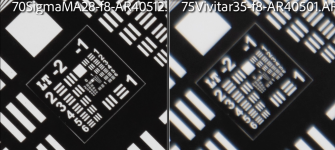
But, for serious comparison of lenses, I look at 400%, again this is extreme corner:
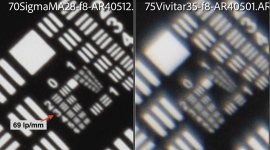
Vlad's test target is very helpful for judging image quality across the frame, for checking alignment (all four corners equally in focus), and for comparing lenses. This target is available from my good friend Vlad at: https://www.etsy.com/shop/SilverKnits

But, for serious comparison of lenses, I look at 400%, again this is extreme corner:

Vlad's test target is very helpful for judging image quality across the frame, for checking alignment (all four corners equally in focus), and for comparing lenses. This target is available from my good friend Vlad at: https://www.etsy.com/shop/SilverKnits
571514m3
Established
I’m impressed with your results at f8 and even f11 considering that lens resolution drops when stepped down.
On printing. I use an Epson ET8550 having had enough of the troublesome and expensive P800. A 8x10 or A4 printed at 300dpi would barely need a 8MP file, and I’ve had surprising results with old 3 to 5Mp files. So these results are really encouraging for low tech scanning using readily available and cheap lenses. Seems that 5-18Mp files will do nicely for run of the mill printing.
Great topic!
On printing. I use an Epson ET8550 having had enough of the troublesome and expensive P800. A 8x10 or A4 printed at 300dpi would barely need a 8MP file, and I’ve had surprising results with old 3 to 5Mp files. So these results are really encouraging for low tech scanning using readily available and cheap lenses. Seems that 5-18Mp files will do nicely for run of the mill printing.
Great topic!
besk
Well-known
Your work really is helpful. I own several of the lenses tested including the 55 f/2.8 Micro Nikkor and the Vivitar 75 f/3.5. Was planning on using it and a Sony nex-C3 (16mp) to copy some old slides for small enlargements.
. Looks like almost "any old lens will do."
. Looks like almost "any old lens will do."
ColSebastianMoran
( IRL Richard Karash )
These are the lenses which tested with image quality I judged as unacceptable due to CA, low contrast, or loss of resolution in my mid-corner measurement.
Group 5 - Lesser Lenses (1-Star)
50 f/1.8 NikonE prime lens on extension tubes G5-E4, CA
50 f/2 Nikkor AI prime lens on ext tube (G5-E4, severe CA, good contrast)
50 f/2.8N El-Nikkor (newer version, plastic body, small numerals, just not good at 1x; G5-E3, severe CA, the older 50 f/2.8 El-Nikkor is much better at 1x)
105 f/2.8 Micro-Nikkor AF on D7200
105 f/4 Noflexar (G5-E5, CA, lower contrast)
105 f/4 MicroNikkor with stacked 105/4 Bellows Nikkor (as suggested by Rørslett, G6-E1, lower contrast)
Group 5 - Lesser Lenses (1-Star)
50 f/1.8 NikonE prime lens on extension tubes G5-E4, CA
50 f/2 Nikkor AI prime lens on ext tube (G5-E4, severe CA, good contrast)
50 f/2.8N El-Nikkor (newer version, plastic body, small numerals, just not good at 1x; G5-E3, severe CA, the older 50 f/2.8 El-Nikkor is much better at 1x)
105 f/2.8 Micro-Nikkor AF on D7200
105 f/4 Noflexar (G5-E5, CA, lower contrast)
105 f/4 MicroNikkor with stacked 105/4 Bellows Nikkor (as suggested by Rørslett, G6-E1, lower contrast)
Share:
-
This site uses cookies to help personalise content, tailor your experience and to keep you logged in if you register.
By continuing to use this site, you are consenting to our use of cookies.


